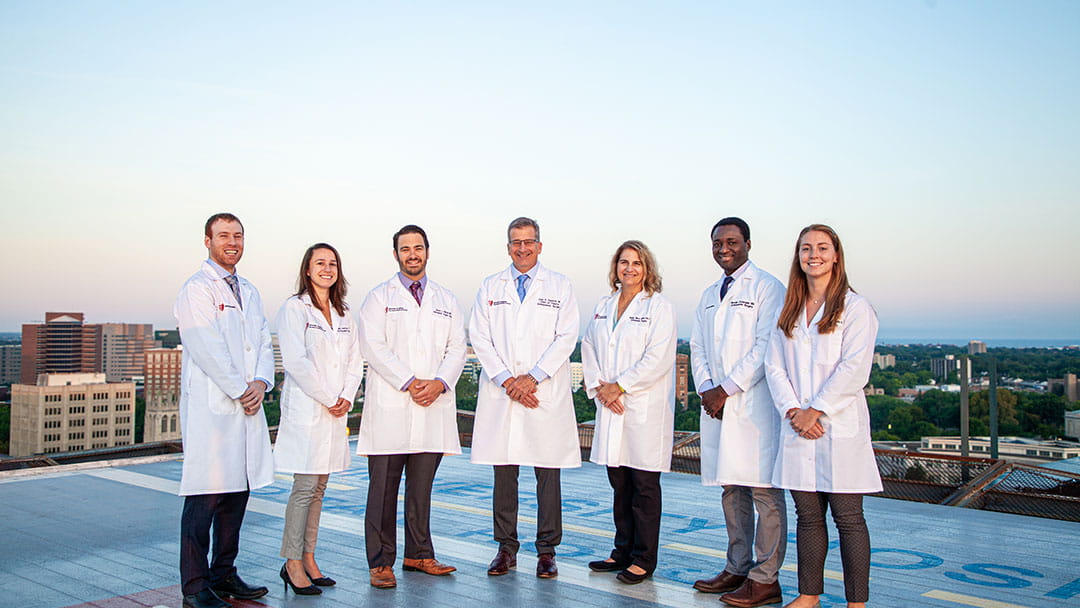Orthopedic Trauma Volume Grows During COVID-19
October 25, 2020
Department acts quickly to implement new protocols while handling increase in surgeries
Innovations in Orthopaedics | Fall 2020
In a pandemic, healthcare systems can pause elective surgeries, but emergency departments can’t delay treatment to patients with life-threatening injuries.
University Hospitals Cleveland Medical Center’s Level 1 Trauma Center never really slowed down in 2020; in fact, orthopedic trauma surgeons were busier than ever.
James E. Voos, MD, Chair of UH Department of Orthopedics, said July 2020 orthopedic volume exceeded July 2019 volume. John Sontich, MD, Division Chief, Orthopedic Trauma and Post-Traumatic Reconstruction, UH Cleveland Medical Center, and Associate Professor of Orthopedics, Case Western Reserve University School of Medicine, says orthopedic trauma volume increased 20% in the second quarter of this year.
“As a department, that means not only do we have to accommodate everyone’s safety, but also the increase in surgical volume,” Dr. Voos says. “That puts a dual strain on our teams, with busier call nights and cases filling the OR. Dr. Sontich worked well with the trauma team to create an efficient schedule and program to accommodate the increase in cases.”
The orthopedic trauma team has a few theories to explain the surge:
- Transfers. Many of the 18 hospitals throughout the UH system have had to “gear down,” Dr. Sontich says. Smaller facilities simply don’t have the resources to accommodate their usual volume of trauma cases given the level of sanitation and protection needed to keep everyone safe. Those facilities re-route patients to UH Cleveland Medical Center when possible.
- More trauma overall. Ohio State Highway Patrol recorded 46 more traffic fatalities in 2020 compared to the same timeframe in 2019 (through October 7). An Ohio State University study also found more incidents of speeding in Cleveland, Cincinnati and Columbus. More speeding translates to more crashes and more people seeking trauma care. Dr. Sontich has also noticed an increase in penetrating trauma (gunshot wounds) and more pedestrian and cycling accidents.
- Alcohol use. According to Accenture COVID-19 research, Americans aren’t drinking more alcohol this year overall; however, alcohol use generally leads to risky behavior, which can lead to trauma. Alcohol combined with stress from job loss and/or sheltering in place is a dangerous cocktail.
HOW ORTHOPAEDIC TRAUMA HANDLED THE SURGE
The trauma center made dramatic changes in operating room procedures to accommodate increased surgical volume while protecting patients, clinicians and physicians. First, every patient who entered the ED got screened and/or tested for COVID-19 symptoms.
In the early months, it took at least a few days to receive COVID-19 test results — not much help in an acute setting. By late May, the trauma department had received rapid tests to use in extreme situations.
In addition to universal testing, the trauma team enlisted the following protocols before and after surgery:
- Surgeons enter a secure, sterile, empty room to change clothes. They put on disposable suits, N95 masks, a surgical mask to cover the N95 mask, and a hood.
- Only central anesthesiologists are allowed in the OR during anesthesia due to airborne infection risks. Surgery begins a half hour after intubating.
- After surgery, physicians re-enter the secure, sterile, empty room. They discard the PPE, sanitize hands, shower using mandated soap, and change into scrubs.
- At the end of the day, surgeons discard scrubs completely, shower again, put on street clothes, and head home.
- Nurses and clinicians follow similarly rigorous protocols.
- COVID-19 patients are scheduled for surgery at the end of the day, when the OR is less occupied, when possible.
“We continue to follow these protocols today,” Dr. Sontich says. “We’ve been successful so far in preventing infection, and we can’t let our guard down.”
Trauma Center Research Director and orthopedic surgeon George Ochenjele, MD, says the protocol helps ease the worries of patients anxious about entering the ER. Dr. Ochenjele is also the Research Director of the Level 1 Trauma Center and Assistant Professor at the School of Medicine.
“Patients with injuries who walk into ER, you can see the hesitation: am I going to be safe?” Dr. Ochenjele says. “Testing and safety measures provide an element of reassurance.”
SURGEONS AVAILABLE 24/7
 UH Level 1 Trauma team.
UH Level 1 Trauma team.Now that elective surgery volume has returned to pre-COVID levels, the orthopedic trauma surgeons, some of whom also perform elective procedures, are consistently booked. “Our four orthopedic trauma surgeons take call every day, either as primary or as backup on weekends,” Dr. Sontich says. “But we never turn down a referral.”
By working through an experience the world has not seen in 100 years, the orthopedic trauma team is stronger than ever.
“I’m so proud of our team and our nursing staff,” Dr. Ochenjele. says. “My attitude at the height of the pandemic was, ‘This is wartime surgery.’ It was something everyone could identify with and motivated us to work together to take care of our patients. Now that the tension is lower, we still have that bond. And that phrase captures all the emotions and experiences we went through together.”
To refer a patient to orthopedic trauma, call the UH Transfer Referral Center at 216-844-1111.


